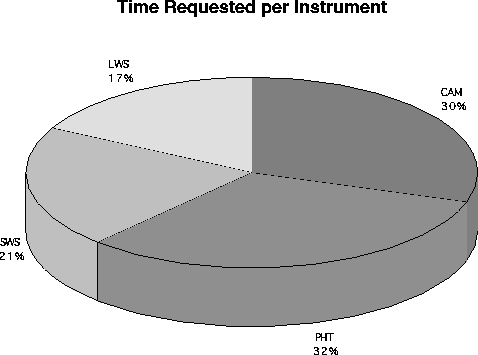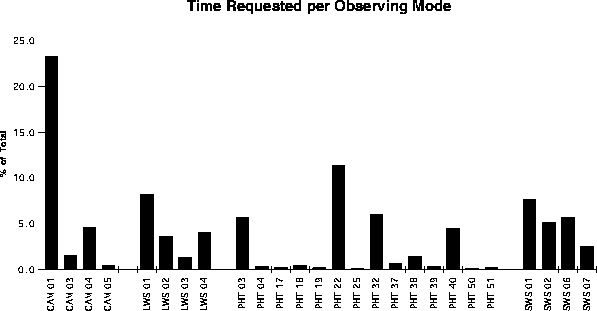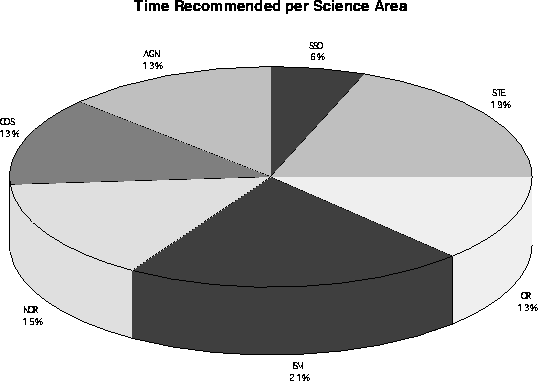
Figure 1: Division of requests between four instruments on basis of time.
The ISO Supplemental Call for Observing Proposals was released at the beginning of August 1996 with due dates of 7 and 9 October for electronic and paper proposals, respectively. A total of 551 proposals was received. Figure 1 shows how the requested time was distributed between the four instruments. More details ---at the level of the individual observing modes (AOTs)--- are given in figure 2. [A similar analysis will be presented in a later ISO INFO for the results of the Supplemental Call once phase 2 data entry has been completed].

Figure 1: Division of requests between four instruments on basis of time.

Given the number of proposals, the Observing Time Allocation Committee (OTAC) was slightly smaller in size from the pre-launch Call. It consisted of 33 members, of whom 30 had been involved in the pre-launch Call. As before, the OTAC was organised into seven panels addressing different scientific areas, namely: solar system (SSO); stellar (STE); circumstellar (CIR); interstellar medium (ISM); normal and starburst galaxies (NOR); active galaxies and quasars (AGN); and cosmology (COS). Each of the OTAC panels met individually to make their recommendations, which were reviewed and homogenised by a meeting of the Panel Chairs. The results were then sent to the ESA Director of Science for review and release. Proposers were informed individually of the results in early December and a complete list of the successful proposals is being prepared for the WWW.

Figure 3: Time recommended by OTAC panels per science area (SSO = solar system; STE = stellar; CIR = circumstellar; ISM = interstellar medium; NOR = normal and starburst galaxies; AGN = active galaxies and quasars; COS = cosmology).
Recommendations were made by OTAC for about 1900 hours of time in 2 priority classes (1 and 2). It is expected that most of these observations will be scheduled before the end of the mission; ESA will try to execute the priority 1 observations even if it entails some loss of observing efficiency. Additional observations were recommended as priority 3 to maintain the necessary level of priority 1 plus 2 time between the science areas of the OTAC recommendations. Overall, the recommended observations are distributed over a total of 330 proposals.
In the notifications to proposers a number of detailed caveats have been made. Inter alia, it has been emphasised that, due to operational constraints, no guarantee can be given that any particular observation will be carried out. Should there be significant deviations during the phase 2 data entry process from phase 1 expectations or should the expected performance of as-yet-unreleased observing modes not be reached, the OTAC may re-examine their recommendations.
Martin Kessler,
ISO Project Scientist.
Updated: 13 December 1996